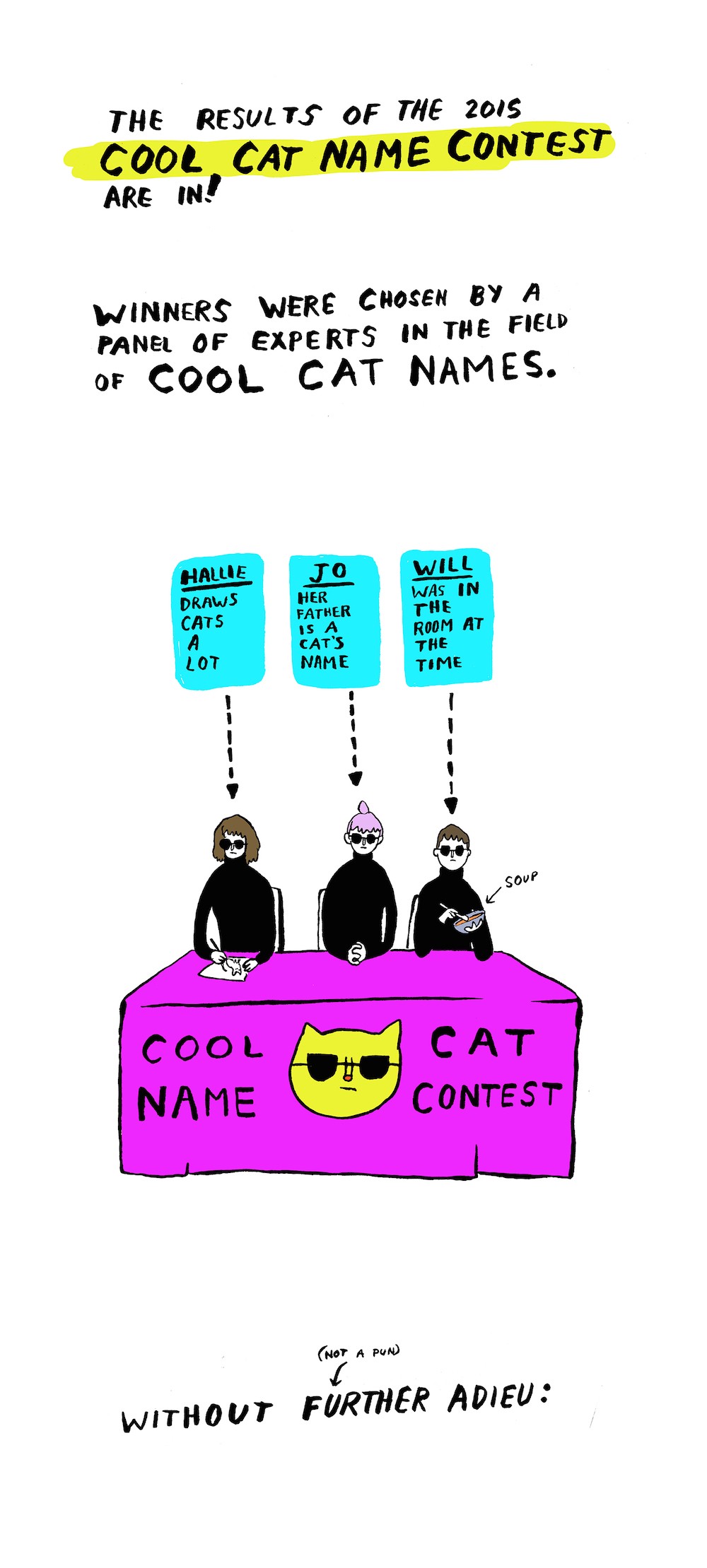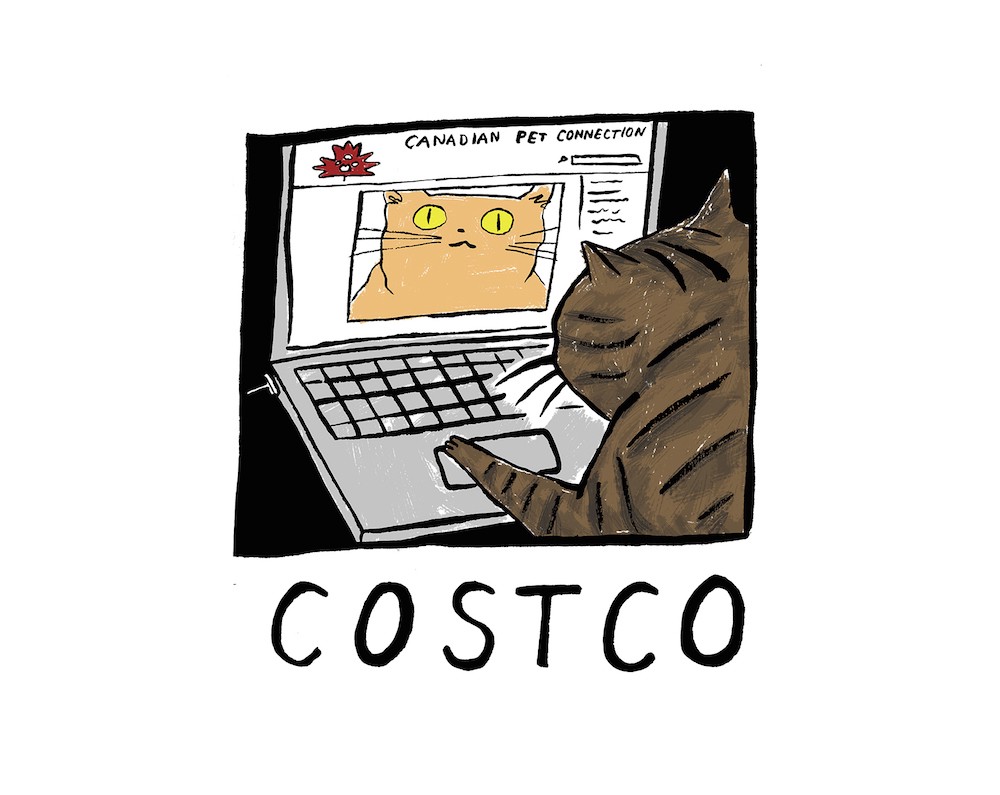New York City, February 18, 2015

★★ Pretty colors floated in the air above the river. Cirrus clouds moved by, and then cumulus ones, carrying the general rose-gold tinge with them. A gentle cloud parade, to watch from the couch while flattened by a cold: more cirrus, and even a little stratus over New Jersey, as brilliant bands of tarnished light stretched across the southwest. Outside, at last, in the evening, the newer snow on the black snowbanks looked like some wholly unrelated substance, as alien and separate as spilled candle wax. What felt like a drizzle turned out, on close inspection in the light of a crosswalk signal, to be tiny snowflakes. In the beams of turning headlights they looked exactly like dust motes in a sunny room.
A Poem by Leslie McGrath
by Mark Bibbins, Editor
To the Student Whose Mural Has an AK-47 Aimed at
the Heads of Faculty Members Entering the Ladies’ Room
How old were you when a teacher noticed your
unusually keen eye and the kind of brashness
an artist needs — twelve? Fifteen?
You’re the real thing
my high school English teacher proclaimed
one spring afternoon in my junior year
as he raked his chalky fingers
through his thinning hair.
I’d savaged The Waste Land
in a fury of adolescent cant and AP vocabulary
which earned me an editorship
on the school paper where I ridiculed
a born-again freshman touting The True Way
to God in language so venomous
for weeks our home phone rang
off the hook with indignant threats
from her loved ones.
No explanations. No apologies.
I was the real thing, the future of a world
in need of my independent critical thinking.
My teacher said so as we expanded my cache
of verbal ordnance.
As we honed my skill
in finding targets for self righteousness —
I mean self expression —
as I soaped the windows of our imagined enemies
rang their doorbells
then ran like hell after lighting a bag
of dogshit afire for them to discover
while we high-fived
in the getaway car of my teacher’s praise
of my courageous free speech.
Leslie McGrath’s latest book is Out from the Pleiades, a novella in verse from Jaded Ibis Press.
You will find more poems here. You may contact the editor at poems@theawl.com.
A Luxury Tower on the Upper East Side, a 2br in the Village, a Studio in Greenwich Village
by Brendan O’Connor
Welcome to Surreal Estate, a new column in which we will explore listings from the tumultuous New York City real estate market.
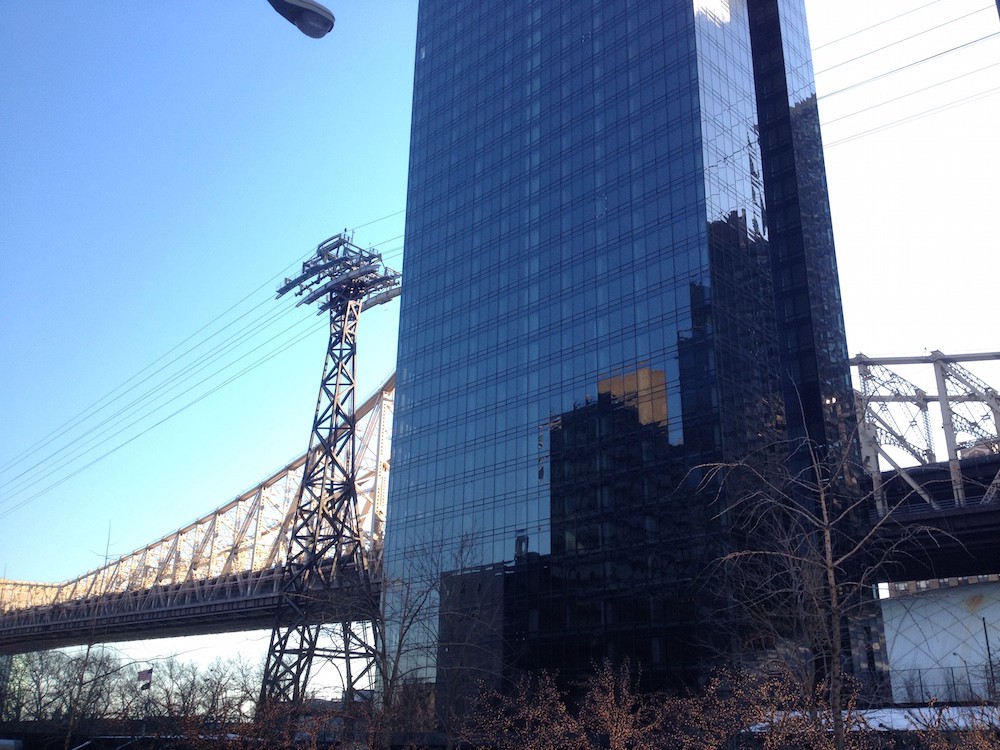
Two Sutton Place North
• $3,020–9,760/month
• 0–3 Bed
On the Upper East Side, two black glass towers pierce the sky above York Avenue immediately north of the Queensboro Bridge. The first was built twelve years ago; the second came to market in October — apartments, starting at $3,020/month, are currently being leased. “There’s nothing really like it on the Upper East Side. It’s so sleek, and modern,” Patricia Coleman-Palacios, a leasing manager with the Solow Management Corporation, said. “We get so many international people, and they all want new construction. Which is great for us!”
Walking through the nine-hundred-and-twenty-square-foot, five-thousand-dollar-a-month, one-bedroom apartment, Coleman-Palacios remarked, “It’s like old school New York.” The windows face north, east, and south. (They call that “triple-exposure.”) The Roosevelt Island Tramway zipped along the southern wall and windows; a woman waved at us. “They can’t really see in,” Coleman-Palacios said.
Despite the fact that the walls are as much glass as they are concrete, and that there is a major bridge less than a block away from the building, the apartments are neither cold nor loud. This speaks to the quality of the construction, Craig DeCecchis, a project director at CitiHabitats, said. “You don’t see this in the rental market,” he told me. When you open the closet doors, the lights inside turn on automatically. “We can’t even get developers in condos to do that,” DeCecchis said. “It’s a proper apartment.”
The building has a gym — private to residents, who must still pay an annual fee — as well as a pool. “It’s convenient,” Patricia said. “You have everything here. You don’t have to go outside!” If you do want to go outside — and, I mean, why would you, it’s so cold — the building offers shuttles to the nearest subway station, at Lexington Avenue.
Studios at Two Sutton Place North start at $3,020/month; one bedrooms (all with one-and-a-half bathrooms!) at $3,910/month; two bedrooms at $7,250/month; and three bedrooms at $9,760/month. “There are families, young professionals, students that go to FIT,” Patricia said, speaking of the renters who have signed leases already. “We have something for everybody.”


Matt Berdoff, an analyst at CAVU Capital Advisors, just spent the past two weeks pretending to be a real estate agent. “In New York, you’re always looking for a boyfriend, a girlfriend, or an apartment,” he said. “There’s always gonna be a bid.”
304 West 14th street, 1C
• $3,395/month
• 2BR/1BA
His roommate of three years just got a job in Boston after promising his girlfriend that he’d move there. The pair broke their lease — resulting in a penalty of two months’ rent if someone doesn’t sign a new, year-long lease by the time they move out this coming weekend. Berdoff, who is moving to NoLiTa from their apartment on West 14th Street, just a few steps from the 8th Avenue L station, took this development in stride. “I got a cleaning lady in here, took some pictures, put them up on Craigslist, StreatEasy, Padmapper,” Berdoff told me. “My buddy even posted the listing on the bulletin board at Goldman.” (Sachs.)
Fortunately, the West Village is a seller’s market. Berdoff sold me on the neighborhood as we sat in his living room — a little more bare than it had been, his roommate having already moved out. (“It looks like a crack den in here,” Berdoff joked.) “I love Greenwich Ave. So many good places to eat,” he said. “But storefront space is so expensive to keep that very six months, three of your favorite restaurants are gone. And there are three new ones.” He added, “It’s continually evolving.”
A potential tenant’s application was approved on Tuesday.

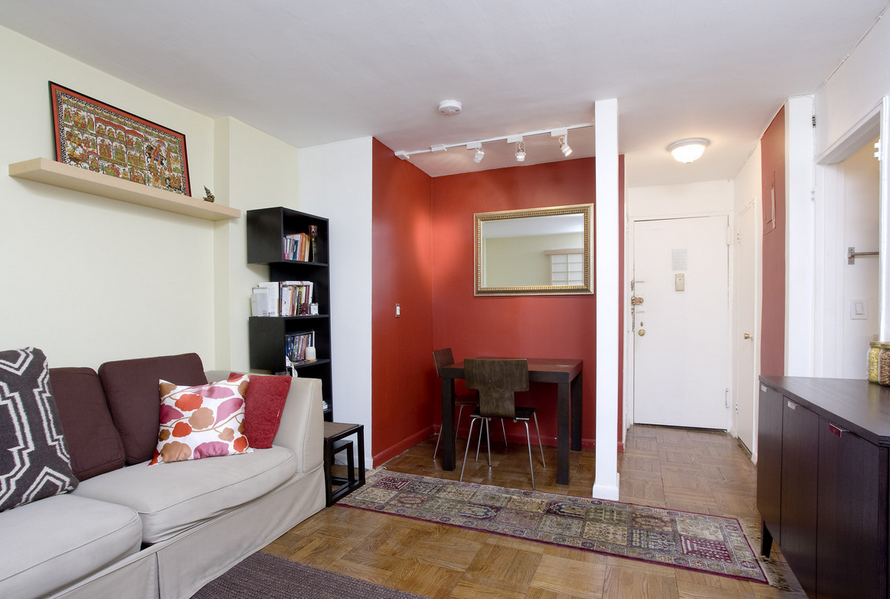
101 West 12th Street, #8D
• $2,800/month
• 430 square feet
• Studio, co-op
Since 2011, Anjali Mangalgiri and her husband Vickram have been splitting their time between India, Singapore, and Greenwich Village. Anjali is the director of a sustainable development start-up based in India; Vickram is a partner at a hedge fund in Singapore. Now, after four years, they’ve decided to rent out their studio in a co-op on the corner of West 12th Street and 6th Avenue.
The couple lived in their four-hundred-and-thirty-square-foot studio from 2005 to 2008. They bought it just after getting married. At the time, it was just one big — well, not so big — room. The couple built out a wall separating the bed from the small living room, removed one of the two closets by the front door and built another in the bedroom. Because the living space is so small, they use the roof — unfortunately closed for the winter — to entertain guests. “You can see all the way to the river,” Mangalgiri said.
“The building is very nice. It’s an old school New York co-op. There are a lot of artists, theater types. It has that Greenwich Village feel,” Mangalgiri said. Incidentally, the building has a name: It is called the John Adams. “The staff has worked here for many years,” she told me. “There’s a full-time doorman and two handymen around the clock. It feels like home — like a community.”
Starting in 2008, they rented the apartment out for two years. In 2011, they started living there again part-time. “We are very global,” Mangalgiri said. “I am very global.” Traveling between Singapore and India will be hard, Anjali said, but “still better than having New York in the mix.” Anjali’s development firm, Grounded, works in Goa, India’s most prosperous state, according to a recent study — a region with abundant greenery that Anjali describes as “an attractive place for second homes.” Grounded’s first home — which, like the John Adams, also has a name: Nivim — was listed in 2013 for seven hundred and forty thousand dollars, according to the Wall Street Journal.
The co-op board is stringent about who may occupy units in the building, Mangalgiri told me. “The board prefers the apartments to be owner-occupied,” she said. “They don’t like pied-a-terres.” As such, prospective renters will have to go through an application process. “They like to know who is living here,” she said. “We would not be able to Airbnb this place.” I asked what the board is looking for in a renter. “Nothing specific,” Mangalgiri paused. “A job?”
Have you noticed a real estate listing that you would like to have investigated? Send cool tips, fun listings, and hot gossip to brendan@theawl.com
Brrrr!
Nothing matters. The stark substance of that brutal truth makes the already terrible task of existence even harder to endure. How is one to contend with the thousand little indignities, the tiny tragedies we cope with each and every day, if in the end it all counts for nothing? We assign meaning to random events and value to objects of no intrinsic worth, but only to keep ourselves from confronting the reality that we are pushed about by forces we cannot comprehend and motives that are mysteries even as we pretend we have agency over them. “I just want people to understand me, to know why I did what I did,” we think when we confront the possibility of our expiry, but there is no explanation that can convey why we made the choices we did when we do not even fully know ourselves. We careen between altruism and avarice and all the possible permutations within and while some of us are more good and some of us are more bad in the end it makes no difference because we every one of us end up in the ground and the ground accepts all without judgment. We should, in fact, take comfort in the idea that no matter how badly we’ve fucked things up for ourselves and others in the end it doesn’t make a difference, but that’s difficult to deal with while simultaneously still doing the damage we do each day and trying to propel ourselves forth to the future even when we know how badly it’s going to turn out. The grave is all we can realistically look forward to. And tomorrow will be even colder.
Introducing the New New New York 'Times'
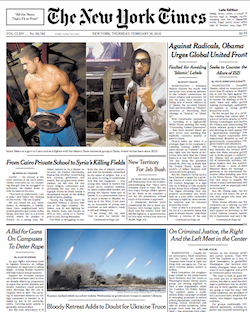
A round of congratulations for the launch of the new Times magazine, which is thick and sturdy and full of things I would like to read. Here, however, is what the other floors in the building are thinking about: a memo that went out this morning.
From: “Baquet, Dean”
To: Newsroom
Subject: New Structure to Our Daily Meetings
All:
I’m excited to announce a small but significant step in our digital transformation.
Next week, we’re going to revamp the structure of our daily meetings and adopt a new system for pitching major enterprise.
These changes are intended to ensure that our digital platforms are much less tethered to print deadlines. We need to be posting more of our best stories not in the late evening, but when The Times’s digital readership is at its height: between 7 a.m. and 7 p.m.
This new system will, in particular, give us more flexibility in targeting readers on mobile (which now receives more than half of our traffic) and on platforms like Facebook (where we are rolling out new strategies for presenting our journalism).
In short, our goal is to further elevate the primacy of our digital platforms in the daily life of the newsroom.
Here are the changes:
• We’re retiring our system of pitching stories for the print Page 1.
• Desks will instead pitch their best enterprise pieces for digital slots on what we’re calling Dean’s List. (I didn’t come up with that name, but I like it!)
• Stories that the masthead selects for Dean’s List will receive the very best play on all our digital platforms — web, mobile, social and others yet to come.
• There will be two Dean’s Lists: one designated after the morning meeting, and one after the afternoon meeting. Each list will typically contain three or four enterprise pieces.
• In general, stories on the lists must be ready for posting shortly after the meeting. In other words, if a desk pitches an enterprise piece for the morning Dean’s List, it must be available for posting by noon or so.
• It’s worth noting that the tradition of selecting Page 1 stories under the old system has long made The Times distinctive. We are seeking to preserve the rigor of this process, but update it for the digital age. Desks will compete for the best digital, rather than print, real estate.
• Desks will continue to pitch news for major digital play at both meetings. Dean’s List slots do not include news — only enterprise.
• In fact, I want to emphasize that I believe that the meetings are an important venue for talking about how we are going to handle the major news of the day. We want to have a robust discussion about lines of coverage and about how our journalism will be presented on different platforms.
• We’ll still select stories for the print Page 1 at the afternoon meeting, but that process will play a less prominent role.
I realize that it will take time for all of us to adjust to this new way of doing things. We’re going to follow up shortly with a memo to the desks about the details and logistics of the new system.
Still, you’ll undoubtedly have questions. Please feel free to reach out to me or other masthead editors.
Dean
No more late-night news piles. No more Page 1 meetings! Hello DEAN’S LIST as well as a new internet publishing schedule that is actually sort of against the grain as far as web publishers go, though I’m not sure it was meant that way?
Blur, "Go Out"
“News of blur’s new album and show was announced exclusively with Facebook at a press conference in London’s Chinatown which also gave fans across the world the chance to be part of the event via a live stream and Q&A.; With millions of fans following blur on Facebook, this was an opportunity for the band to speak directly to their fans in real time, answering questions via their profile page” is what 2015 looks like even if you’re Blur. Anyway, here’s what 2015 sounds like if you’re Blur. Spot the difference.
Financing Ventured
Facing overwhelming demand from institutional investors, Uber has expanded its Series E round of venture financing by $1 billion, according to documents filed Wednesday with the Delaware secretary of state, bringing the total capacity for the round up to $2.8 billion. The move, which was confirmed by Uber, occurred just weeks after the company closed a $1.2 billion round of financing. … The most recent expansion is on top of some $4 billion Uber raised, including a recent $1.6 billion round of convertible debt financing from the clients of the private wealth arm of Goldman Sachs, the investment bank previously confirmed.
Why, you might ask (or not, but whatever), would Uber need all that money — so much that it did not even expect to field that amount? A remarkably concise explanation from CEO Travis Kalanick:
@JeremyShure @ajs @MikeIsaac — Uber’s success is dependent on making transportation as a service sustainably lower cost than owning a car
— travis kalanick (@travisk) February 7, 2015
@JeremyShure @ajs @danprimack @MikeIsaac @Uber if we don’t lower prices sustainably below car ownership, market oppty significantly limited
— travis kalanick (@travisk) February 7, 2015
Building this kind of world-transforming infrastructure is indeed expensive, especially at a truly global scale. But how could it be possibly be sustainable for users to constantly pay another human to drive them around at a price that is still cheaper than owning a car, particularly in cities and suburbs that aren’t exactly dense?
@danprimack fair enough… driverless in 2030 FTW… 🙂 /@MikeIsaac
— travis kalanick (@travisk) February 7, 2015
Oh, right.

